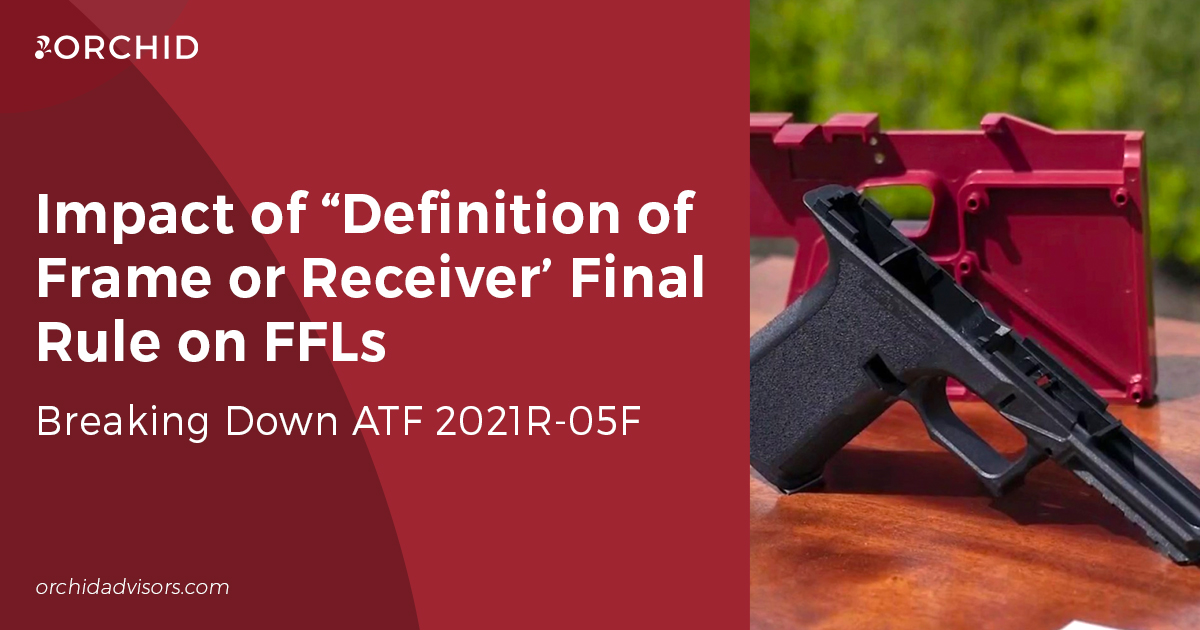Last week, President Joe Biden addressed the nation to outline the administration’s latest efforts to “combat gun crime.” In addition to nominating Steve Dettelbach as ATF Director – his second nominee for the position in as many years – reiterating plans to “go after rogue gun dealers,” and urging Congress to pass universal background checks, ban assault weapons and high-capacity magazines, and overturn PLCAA, Biden announced the finalization of federal rule ATF 2021R-05F, “Definition of ‘Frame or Receiver’ and Identification of Firearms.”
The supposed “weapon of choice for many violent criminals” despite lacking evidence, the final rule cracks down on so-called “ghost guns,” or privately made firearms (PMFs), amending multiple firearms definitions, modifying manufacturing processes and ATF regulations in the process.
Below, we’ll attempt to summarize provisions of the 360-plus page final rule and their impact on FFLs.
Final Rule Changes
Firearms Definitions
“Firearm”
- Term now includes a weapon parts kit that is designed to or may readily be completed, assembled, restored, or otherwise converted to expel a projectile by the action of an explosive.
“Frame or receiver”
- Separately defines “frame” for handguns and “receiver” for rifles, shotguns, and other weapons that expel a projectile other than handguns.
- New definitions describe only a single housing or structural component for one specific fire control component of a given weapon.
- For handguns, it is the housing or structure for the primary energized component designed to hold back the hammer, striker, bolt, or similar component prior to initiation of the firing sequence (i.e., sear or equivalent).
- For rifles, shotguns, and non-handgun projectile weapons, it is the housing or structure for the primary component designed to block or seal the breech prior to initiation of the firing sequence (i.e., bolt, breechblock, or equivalent).
- “Multi-piece frame or receiver” defined as a frame or receiver that may be disassembled into multiple modular subparts; does not include a complete removable chassis from the internal frame of a pistol.
- “Firearm muffler or silencer frame or receiver” amended to define a single component of a complete firearm muffler or silencer device as the frame or receiver.
- Terms “frame” and “receiver” mean the housing or structure for the primary internal component designed to reduce the sound of a projectile (i.e., baffles, baffling material, expansion chamber, or equivalent), formerly “essential internal components.”
- Terms now exclude “a removable end cap of an outer tube or modular piece.”
“Gunsmith”
- Clarifies that licensed dealer-gunsmiths are not required to be licensed as manufacturers if they only perform gunsmithing services on existing firearms for their, or for another licensee’s, customers, because the work is not being performed to create firearms for sale or distribution.
- Gunsmith services may include customizing a customer’s complete weapon by changing its appearance through painting, camouflaging or engraving, applying protective coatings, or by replacing the original barrel, stock or trigger mechanism with drop-in replacement parts.
- Gunsmiths must also place marks of identification on PMFs they purchase and sell that do not already contain serial numbers.
Marking Requirements
Privately Made Firearms
- Requires FFLs to mark and record PMFs only when they are received or otherwise acquired into inventory.
- PMFs may be adjusted or repaired and returned on the same day without marking, thereby treated similarly to commercially produced firearms.
- Allows FFLs to directly supervise a non-licensee who may mark the PMF for the licensee in accordance with the regulations.
- Requires polymer PMFs to be marked by placing the serial number on a metal plate that is permanently embedded into the frame or receiver.
Firearm Serialization
- Clarifies only the serial number and associated license number need be marked in a print size no smaller than 1/16-inch.
- Clarifies “legibly” to mean that the unique identification number within a serial number contains only Roman letters and Arabic numerals.
- Clarifies “conspicuous” to mean that the markings must be capable of being easily seen with the naked eye during normal handling of the firearm.
- Expands circumstances where markings can be adopted to include newly manufactured firearms, manufacturers performing gunsmithing services, and PMFs marked by non-licensees.
- Clarifies non-NFA firearms must be marked within 7 days after completion of the manufacturing process, while NFA firearms must be marked by close of the next business day.
Recordkeeping & Retention
- Clarifies PMFs must be recorded as an acquisition when a licensee places marks of identification, and as a disposition upon return.
- Clarifies manufacturers have 7 days to enter non-NFA firearms into their records, and close of the next business day for manufactured NFA firearms.
- Clarifies manufacturers need not submit ATF Forms 2, “Notice of Firearms Manufactured or Imported,” if firearm muffler or silencer parts are transferred between qualified licensees for further manufacture or to complete new devices that are registered upon completion of the device, or to repair existing registered devices.
- Requires FFLs to maintain records until licensed activity is discontinued; removes 20-year retention period.
Final Rule Impact
During the President’s address, Biden appeared to hold up an “80-percent” lower from Polymer 80, bluntly stating “this is the gun.” Yet, despite the visual demonstration, the final rule fails to provide a clear interpretation of several of its provisions and to what extent manufacturers of firearm and PMFs will be affected.
In the final rule, the definition of “frame or receiver” has been amended to include partially complete, disassembled or nonfunctional frames, receivers and frame/receiver parts kits “readily” made to function as a frame or receiver. Further, partially complete or disassembled billets and blanks of a frame/receiver sold or distributed with jigs or templates to complete such billets/blanks, as well as those with template holes drilled or indexed, and those split but not destroyed, are to be considered frames or receivers. As written, these provisions would render 80-percent kits with indexing for consumer completion or sold with jigs as frames/receivers and, thus, firearms requiring a serial number and background check.
In 2017, the ATF determined Polymer 80 “Glock-style receiver blanks” and similar products “not sufficiently complete to be classified as the frame or receiver of a firearm and thus not a ‘firearm’.” However, the final rule states such determinations will not be grandfathered in and jigs, tools and instructions associated with such partially complete, disassembled, or nonfunctional frames/receivers will be needed to make a proper classification. While often sold together, it’s unknown if selling 80-percent kits separately from jigs would impact such classification.
Unlike partially complete kits, the final rule state articles, including unformed blocks of metal, liquid polymers, and other raw materials, that have not reached a stage of manufacture where they are clearly identifiable as an unfinished component of a frame or receiver are not frames or receivers. Defense Distributed, known for its Ghost Gunner CNC mills, has already suggested such receivers “will become the only legal and affordable method of making an unregistered metal lower” with its “zero-percent” receivers of unformed blocks of aluminum. Time will tell if these will remain legal under the final rule.
Among the final rule’s other provisions, manufacturers and retailers will have a 7-day grace period upon “completion” of non-NFA firearms to mark and acquire firearms, and removes the 20-year retention period for certain FFL records. Per the new regulations, FFLs must retain Forms 4473 and Bound Book records until licensed activity is discontinued. A seemingly small change, this will place an even greater storage burden on firearms businesses.
Immediate Reaction
Following Biden’s announcement, those most impacted by the final rule took to social and traditional media to react.
“We are working with our legal team to fight this unprecedented rule that completely hijacked our legal system and bypassed the formal process of how legislation should be created,” posted 80 Percent Arms on their website with a breakdown of the ruling. “We will be mounting a robust legal challenge to this executive overreach.”
“In response to the White House announcement, Polymer80 intends to mount a rigorous defense of our Second Amendment rights,” the company posted on Instagram. “Polymer80 will continue to operate lawfully. Our products are still legal, however, please be sure to check your state and local regulations to ensure compliance.
That interpretation is shared by Defense Distributed Founder Cody Wilson.
“It looks like there is room still to sell 80-percent receivers, especially ones that have had determination letters,” Wilson told Reason magazine. “But they aren’t saying they’re grandfathering those determinations; they’re saying everybody has to resubmit.”
“I would say if they maintain an 80-percent space and don’t allow people to buy a simple kit, then Ghost Gunner market share goes way up and then the zero-percent conversation becomes a conversation about the state level on 80s,” Wilson continued. “I was just assuming that the feds would also be shutting that door and I’m just surprised to see that they’re not.”
Next 120 Days & Beyond
The finalized ATF 2021R-05F will take affect 120 days after publication in the federal register, upon which it is imperative your FFL understand the rule’s provisions and potential impact on your firearms operation.
The final rule, including a summary, can be viewed here.
For assistance navigating the final rule, we encourage you to contact Orchid’s experienced compliance, technology and operations specialists and learn more about our on-call compliance services and electronic bound book and digital storage solutions.







0 Comments